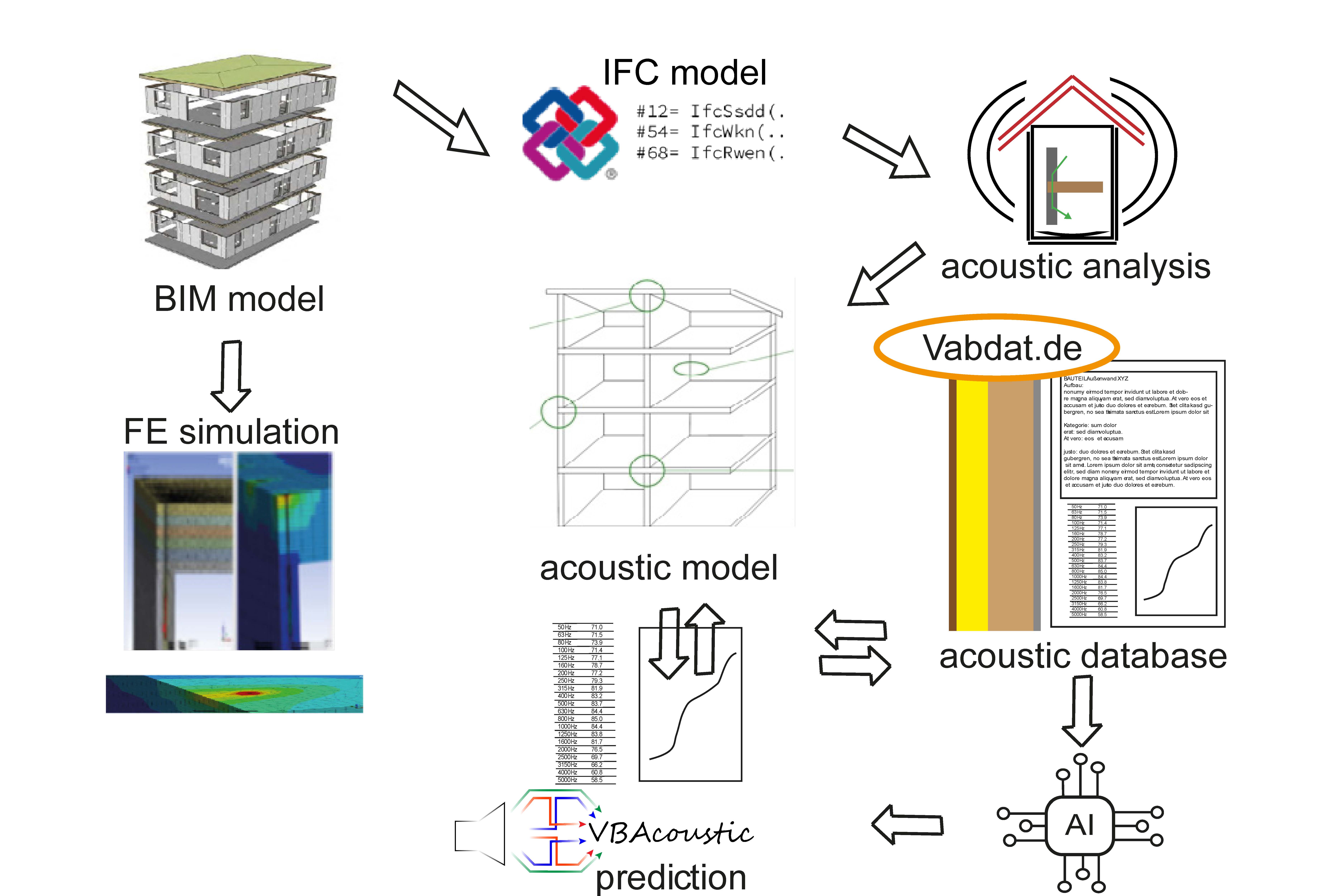Noise protection_FSP Bayern: Prediction method for noise and vibration protection for BIM-based building planning - completion of input data and extension to artificial intelligence methods
Project background
The progress in digitization in the construction industry is enormous, the topic of Building Information Modeling (BIM) is now served by many manufacturers of planning software in the construction sector. Specialist building physics models, particularly for sound insulation, are not yet available on the IFC interface based in OPEN BIM. Since the prognosis calculation for airborne and impact sound transmission is very complex, especially for buildings in timber construction, the verification based on DIN 4109 is to be simplified by using digital methods.
Project objective
The project aims to develop methods for embedding sound insulation planning in an open BIM planning process for timber construction. The aim is to develop a specialist acoustic model for the BIM planning process and to investigate the use of AI methods in sound insulation planning.
Project procedure
The previous research project Vibroacoustics in the planning process for timber buildings has already shown that it is possible to predict the sound and vibration protection of a building using BIM-based planning and the integration of FE modeling methods. However, previous research has focused more on the acoustic classification of the building than on the actual prediction of sound insulation through calculation.
IFC, an internationally standardized, manufacturer-independent data exchange format that makes Open BIM possible, plays a central role in the BIM-based planning process and in the integration of sound insulation planning. It turned out that the IFC data format does not have an existing data structure for the description of joints, which are extremely important for sound transmission. The scientific focus is currently on implementing or linking the research results from previous research projects such as the VBAcoustic calculation tool and the VaBDat database to BIM - including through the further development of IFC. When implementing the forecasting methods in an Open BIM process, the aim is to work closely with the committees from buildingSMART in order to achieve adjustments to the IFC schema. In addition, artificial intelligence (AI) methods are to be used to forecast sound insulation.
Innovation
The use of artificial intelligence in noise protection forecasting is still completely new. There are already initial approaches to the use of AI in the field of planning and construction, although the focus is on optimizing the construction process and not on building physics planning. The use of statistical methods to generate input data for sound insulation prediction was successfully used in the Vibroacoustics research project in the planning process for timber buildings.
As an extension, it is now to be investigated whether AI methods can be used to carry out a prediction calculation for sound insulation for components based on constructive input data from BIM.
Overall lead for THRO input
T +49 (0) 8031 / 805 - 2407 Ulrich.Schanda[at]th-rosenheim.de
ORCID iD: 0009-0008-3988-9288
Project lead
T +49 (0) 8031 / 805 - 2532 Andreas.Mayr[at]th-rosenheim.de
ORCID iD: 0000-0003-2843-1825
Sub-project lead
T +49 (0) 8031 / 805 - 2425 ulrich.wellisch[at]th-rosenheim.de
ORCID iD: 0009-0008-6257-4495
Project staff
T +49 (0) 8031 / 805 - 2479 Camille.Chateauvieux-Hellwig[at]th-rosenheim.de
ORCID iD: 0009-0006-5093-3054
T +49 (0) 8031 / 805 - 2588 Tobias.Kruse[at]th-rosenheim.de
ORCID iD: 0009-0008-7958-1560
T 0 8031 805-2694 Michael.Parzinger[at]th-rosenheim.de
ORCID iD: 0000-0002-2102-0647
T +49 (0) 8031 / 805 - 2589 Fabian.Schoepfer[at]th-rosenheim.de
ORCID iD: 0009-0000-2809-2953
T +49 (0) 8031 805-2941 yvonne.weise[at]th-rosenheim.de
Project duration
2021-01-01 - 2025-12-31Project partners
Project funding

Funding programme
Programm zur Förderung der angewandten Forschung und Entwicklung an Hochschulen für angewandte Wissenschaften - Fachhochschulen


